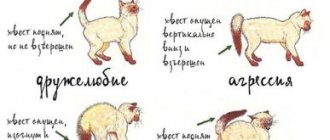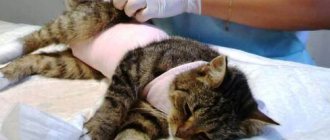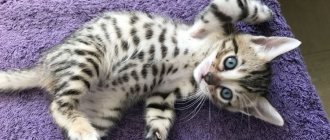How music for cats came about - an experiment by David Teja
Composer David Teye has been experimenting with music for a long time to find compositions that cats and kittens would enjoy, calm them down and relax. To do this, he, a man with an allergy to cat fur, went to a special anti-cafe and played his sets there specifically for pets. However, the furry inhabitants of the public place did not want to listen to the works of the famous composer.
The musician himself said that these were not his first experiments. He joked that if the cats turned away from him the first time he tried to play their favorite music, he would have abandoned his experiment.
Two compositions for cats were written by Tey back in 2008. They received a number of positive reviews from tailed pets. The research was carried out by scientists from the publication Applied Science in Animal Behavior. It was this fact that gave impetus to the musician’s great experiment.
The man abandoned his work in the main orchestra of the United States of America and since 2003 has been composing music that cats would like. According to the cellist's theory, you need to write based on deep emotions and the beating of your heart. For example, monkeys have an accelerated pulse and heart rate, so they like fast and loud music.
David's dream is to be able to work on creating special music sets that will relax or entertain animals. But first, before investors or other cash injections appear, we need to write magic rhythms for cats and dogs, since people, first of all, take care of their pets, who are always nearby.
Realizing that cats would prefer melodies that sound similar to their voices, he began conducting experiments and recording small sections of the composition using computer programs. Various tricks were used, he played chords on the violin, inserted the sound of a cat's purring, overlaid the sonorous voices of kittens, and also mixed it all into one masterpiece.
After some time, the musical opera was written. Soon he went to check on her in the same cafe, this time 6 cats immediately turned around at the sound. And one of them even came up to the pump and began to sniff it. Teyi plunged into complete peace and began to listen to the song of musical instruments performed in the “cat” language.
Due to the lack of funding, the managers found a way out to develop the project. Advertising of music for cats is carried out only on social networks, as well as through cold calls. During this time, many famous bloggers have already agreed to try the effect of music on their pets.
How do cats hear?
It is important to understand that cats hear differently than humans. Their hearing and the way they detect sound is incredibly complex and can vary in duration, frequency and intensity.
To understand how cats hear, you can compare their capabilities with other animals. Different species perceive sounds in different ranges, for example:
- Wax moth: up to 300 kHz.
- Dolphins: 20 Hz to 150 kHz (seven times that of humans).
- Bats: 50 Hz to 20 kHz.
- Dogs: 10,000 to 50,000 Hz (four times that of humans).
- Cats: 30 to 65,000 Hz.
- Humans: 20 Hz to 20,000 Hz.
Hertz is a unit of measurement of the frequency of vibrational motion, in this case sound.
Further development of the “Music for Cats” project
This is how the project gained popularity. Today, cat owners often post videos of their pet dancing or simply reacting to music specially recorded for the animal. The first moments while listening to music were posted by the owner of the famous online cats Marmalade and Cole. The owner of the furry pets explained that they did not have a special reaction, but interest was clearly visible on their faces.
Some people claim that music can calm their pets. Others, on the contrary, say that instrumental compositions awaken a cheerful disposition in their cats. Some owners who have tried the new sound on their cats say that these are real lullabies that help them sleep.
The compositions are collected on the website musicforcats.com, where anyone can listen to them absolutely free. Meanwhile, composer David Tahy is preparing to record a full-length album exclusively for pets.
In future prospects, creating music that dogs will like. But in this matter there are fears that pets will begin to “sing along” to the original. In this case, the neighbors will not be happy.
Cat music calmed cats better than classical human music
Foil cat is in a good mood
You can reduce stress for cats during an examination at a veterinary clinic using music specially recorded for them with the sounds of kittens purring and feeding. This was found out by American scientists who played 21 cats either cat music, classical music, or nothing at all. Subjective behavioral indicators of stress in the first case in animals decreased, scientists write in the Journal of Feline Medicine and Surgery
.
One of the important effects of music is to change the psychological state of the person who listens to it. This is why various melodies are often used, for example, in psychotherapy, and a meta-analysis conducted a couple of years ago even showed that music can reduce anxiety and reduce pain in surgical patients after surgery.
Interestingly, the calming effect of music has been successfully tested not only on humans, but also on animals: classical music, for example, reduces stress in dogs living in shelters, as well as in cats during visits to veterinary clinics. It is assumed that it is not human music that may be more effective in reducing stress in animals, but melodies that are created specifically for other species, taking into account, for example, the range of sound frequencies perceived by them and the characteristics of natural communication. For example, David Teie from the University of Maryland in 2015 recorded several compositions in which he used cat sounds and melodies in the range of their vocalizations (from 55 to 200 hertz): with the help of a small study, he showed that cats are actually They prefer this kind of music to human music.
Amanda Hampton of Louisiana State University and her colleagues used one of Thaye's compositions to test how cats' stress levels changed in response to feline and human music. Their study involved 21 cats, all of which had to undergo three checkups with a veterinarian, each two weeks apart. During each examination, the cats were randomly played either classical music (“Elegy” by Gabriel Fauré), cat music (“Scooter Beer’s Aria” by David Thaye), or nothing at all.
Before, during and after each examination, the researchers measured the animals' stress levels using a special behavioral questionnaire and assessing their reactions to the person nearby, and the scientists used the ratio of neutrophils to lymphocytes in the blood as a physiological indicator of stress.
Stress scores and reactions to people in cats did not differ before the examination, but during the examination, both indicators were lower in cats that listened to cat music, compared to those animals that were played classical music or nothing. Music did not affect physiological indicators of stress. Interestingly, the cats who listened to cat music also had significantly lower levels of stress after the examination ended—when the music was turned off.
Indicators of stress and reactions to a person during an experiment when listening to classical music (red), cat music (green) or silence (blue)
Amanda Hampton et al. / Journal of Feline Medicine and Surgery, 2020
Share
The researchers have thus confirmed that cats actually respond more readily to music specially created for them: the sounds of kittens purring and feeding, which were used in the recording, appear to have a calming effect on cats. As for physiological indicators, scientists note that the ratio of the level of neutrophils to lymphocytes in response to stress increases sharply in response to a stressful situation and returns to normal only after a few hours: most likely physiological stress was caused by transporting the cat to the veterinary clinic, and its level I didn’t have time to fall during the 20-minute examination using music. That's why scientists are pushing to re-measure these indicators in another study, perhaps over time.
In general, the editor’s favorite news about animals listening to music is about a 2021 study that studied the auditory perception of crocodiles. In it, animals that were put into an MRI were played Bach's Brandenburg Concerto.
Elizaveta Ivtushok
Review of music for cats
Scientists have proven that cats love music and prefer to listen to it in their own range of tones and tempo, as they have a more subtle hearing than humans. Among the music tracks presented for cats on the Internet, there are instrumental sets using guitar, violin, and cello.
In addition, the list includes popular children's songs about the fox Alice and the cat Basilio, Bayun and others. However, experts who study the reactions of cats say that they do not understand words. It is better if they are provided with calm instrumental music to listen to, which people use to fall asleep.
Collections on well-known music sites include music of various genres and moods. There are cheerful, broken tunes, as well as serious soothing sets, sounds of nature, garden and forest, relaxing and intended for real relaxation.
What kind of music is not suitable for cats?
If it’s clear with compositions that are pleasant to the cat’s ear, then it is logical that there are tracks that are completely unsuitable for cats.
The genres of rock and pop music cause a reaction of bewilderment in cats, sometimes anxiety, but more often fear. Cats do not perceive sharp compositions with loud inserts and sharp transitions well. Conventionally, all cats can be called grandmothers who do not accept modern trends in youth music.
INTERESTING: Soothing music is useful for cats during long journeys or before surgery. But with sharp compositions, on the contrary, you can scare away unwanted cats from your territory at home.
According to the results of a study by the University of Lisbon, the most irritating composition for cats was identified. It is the song “Thunderstruck” by AC/DC, which caused stress and a clearly negative reaction when played in all animals in the test group.
Why do animals react this way?
It is impossible to determine exactly what feelings singing evokes in cats.
However, there are several versions. Pets distinguish notes. Some sounds of the human voice remind them of the squeak of a kitten, some - the groans of a wounded cat or aggression. In addition, a cat's ear distinguishes sounds better than a human's, so some sounds irritate cats and seem unbearable to them.
We also recommend reading:
Pet habits: what signals should you pay attention to? Top 7 Dogs That Are Great for Children Stubborn Personality: Dogs That Are Difficult to Train Ways to Correct Malocclusion in Puppies
If a cat, having heard singing, ran up to you, began to rub against your legs and ask to be held, purr and try to hug you with its paws, then the pet believes that you need help and support. Many owners notice similar behavior in their pets when whistling. They probably perceive certain sounds as cries for help, for example, in case of fear or pain. In this situation, you need to stop singing and let the cat know that everything is fine and there is no need to worry.
Aggression can be a manifestation of fear. A voice can frighten a cat, cause irritation, and alert the animal. She may think that the owner wants to warn her about the attack. There is no need to test your pet's nerves; stop singing at the first sign of aggression.
FIRST METHOD: MUSIC
Cats may not have an ear for music, but they can hear perfectly well. But they perceive music differently than we do. Scientists from the Department of Psychology at the University of Wisconsin, together with musicians from the Conservatory at the University of Maryland, experimentally found out what kind of music cats like (the full text of the study is here). In short: the frequency range of sounds and the tempo of the music should correspond to the sounds and tempo of natural communication of cats.
This very “natural communication” of cats can be different. They may scream, hiss, or beg for food. Or they can rumble, purr and even snore. It follows that music similar to hissing and screaming will excite them. And similar to rumbling and purring - calming. At the same time, young cats react to music more strongly than older ones.
Low-frequency vibration, rumbling sounds, chirping birds, chirping insects and a slowly flowing melody - this is the recipe for building music for cats. When you go to work, go to the veterinarian, or go on vacation and leave your cat with a friend, play music for him so that he doesn’t worry so much.
Where can I find music for cats? You can Google it, or you can turn on Internet radio and listen to it on endless repeat. Here are the most successful examples of cat music:
— David Thea’s famous album “Music for Cats,” which we already wrote about: listen here .
— nine (!) albums of music and relaxing sounds from “Cat Music” at once: listen here .
But remember that cats' musical tastes may vary. For example, one of our cats remained indifferent to the scientific approach of David Thea, but liked the simple new age from “Cat Music”.











